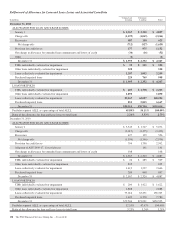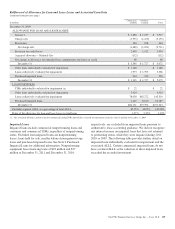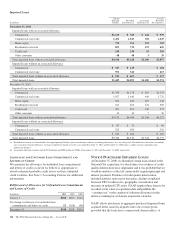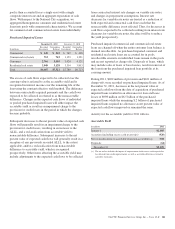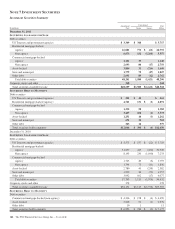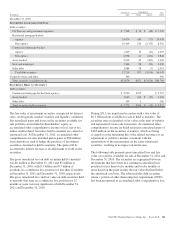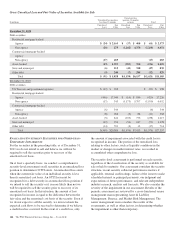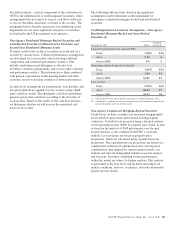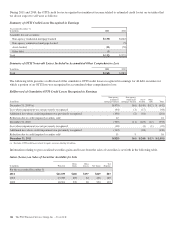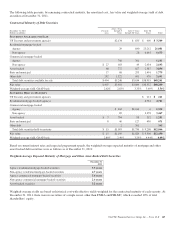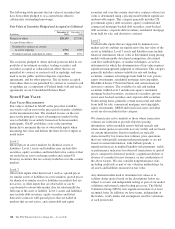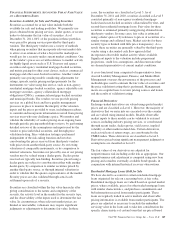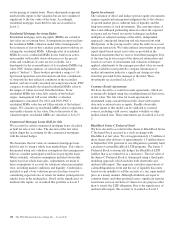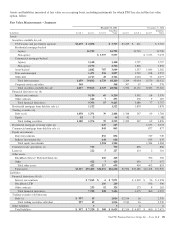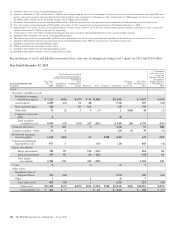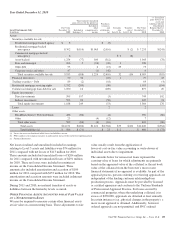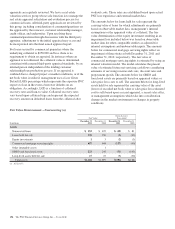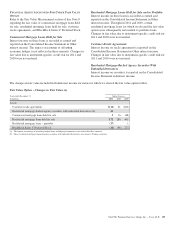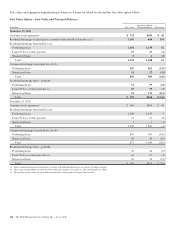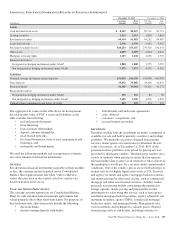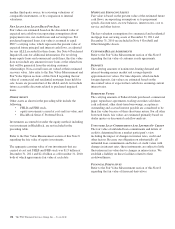PNC Bank 2011 Annual Report Download - page 157
Download and view the complete annual report
Please find page 157 of the 2011 PNC Bank annual report below. You can navigate through the pages in the report by either clicking on the pages listed below, or by using the keyword search tool below to find specific information within the annual report.
The following table presents the fair value of securities that
have been either pledged to or accepted from others to
collateralize outstanding borrowings.
Fair Value of Securities Pledged and Accepted as Collateral
In millions
December 31
2011
December 31
2010
Pledged to others $20,109 $27,985
Accepted from others:
Permitted by contract or custom
to sell or repledge 1,796 3,529
Permitted amount repledged to others 892 1,971
The securities pledged to others include positions held in our
portfolio of investment securities, trading securities, and
securities accepted as collateral from others that we are
permitted by contract or custom to sell or repledge, and were
used to secure public and trust deposits, repurchase
agreements, and for other purposes. The securities accepted
from others that we are permitted by contract or custom to sell
or repledge are a component of Federal funds sold and resale
agreements on our Consolidated Balance Sheet.
N
OTE
8F
AIR
V
ALUE
F
AIR
V
ALUE
M
EASUREMENT
Fair value is defined in GAAP as the price that would be
received to sell an asset or the price paid to transfer a liability
on the measurement date. The standard focuses on the exit
price in the principal or most advantageous market for the
asset or liability in an orderly transaction between market
participants. GAAP establishes a fair value reporting
hierarchy to maximize the use of observable inputs when
measuring fair value and defines the three levels of inputs as
noted below.
Level 1
Quoted prices in active markets for identical assets or
liabilities. Level 1 assets and liabilities may include debt
securities, equity securities and listed derivative contracts that
are traded in an active exchange market and certain US
Treasury securities that are actively traded in over-the-counter
markets.
Level 2
Observable inputs other than Level 1 such as: quoted prices
for similar assets or liabilities in active markets, quoted prices
for identical or similar assets or liabilities in markets that are
not active, or other inputs that are observable or can be
corroborated to observable market data for substantially the
full term of the asset or liability. Level 2 assets and liabilities
may include debt securities, equity securities and listed
derivative contracts with quoted prices that are traded in
markets that are not active, and certain debt and equity
securities and over-the-counter derivative contracts whose fair
value is determined using a pricing model without significant
unobservable inputs. This category generally includes US
government agency debt securities, agency residential and
commercial mortgage-backed debt securities, asset-backed
debt securities, corporate debt securities, residential mortgage
loans held for sale, and derivative contracts.
Level 3
Unobservable inputs that are supported by minimal or no
market activity and that are significant to the fair value of the
assets or liabilities. Level 3 assets and liabilities may include
financial instruments whose value is determined using pricing
models with internally developed assumptions, discounted
cash flow methodologies, or similar techniques, as well as
instruments for which the determination of fair value requires
significant management judgment or estimation. This category
generally includes certain available for sale and trading
securities, commercial mortgage loans held for sale, private
equity investments, residential mortgage servicing rights,
BlackRock Series C Preferred Stock and certain financial
derivative contracts. The available for sale and trading
securities within Level 3 include non-agency residential
mortgage-backed securities, auction rate securities, private-
issuer asset-backed securities and corporate debt securities.
Nonrecurring items, primarily certain nonaccrual and other
loans held for sale, commercial mortgage servicing rights,
equity investments, OREO and foreclosed assets and other
assets are also included in this category.
We characterize active markets as those where transaction
volumes are sufficient to provide objective pricing
information, with reasonably narrow bid/ask spreads and
where dealer quotes received do not vary widely and are based
on current information. Inactive markets are typically
characterized by low transaction volumes, price quotations
that vary substantially among market participants or are not
based on current information, wide bid/ask spreads, a
significant increase in implied liquidity risk premiums, yields,
or performance indicators for observed transactions or quoted
prices compared to historical periods, a significant decline or
absence of a market for new issuance, or any combination of
the above factors. We also consider nonperformance risks
including credit risk as part of our valuation methodology for
all assets and liabilities measured at fair value.
Any internal models used to determine fair values or to
validate dealer quotes based on the descriptions below are
subject to review and independent testing as part of our model
validation and internal control testing processes. The Model
Validation Group (MVG) tests significant models on at least
an annual basis. In addition, we have teams, independent of
the traders, verify marks and assumptions used for valuations
at each period end.
148 The PNC Financial Services Group, Inc. – Form 10-K


